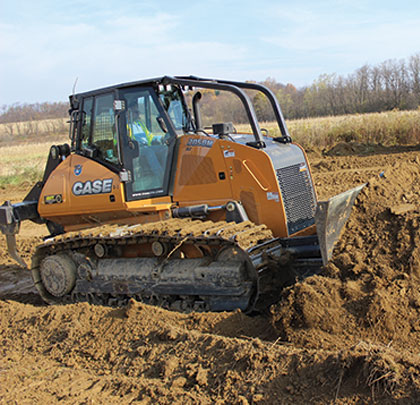With a name like Steele in Pennsylvania, you’d expect Steele Construction, Inc. owner Bill Steele to specialize in structural steel construction, or to own a foundry. Instead, he’s recognized as one of the premier builders of timber-framed homes in the state. As new housing starts dipped during “The Great Recession,” Steele further grew his business on the strength of the Marcellus Shale natural gas boom.
“We were lucky enough to get into a gas contract, and now our company is pretty much evenly split between the building of heavy timber frame and moving dirt,” says Steele.
The company specializes in site reclamation at new gas extraction sites: When a well pad is finished, it may only take up about an acre of space—but the surrounding area that was affected by the construction must be put back to its natural state.
“Time is money and the gas companies want the reclaiming done within [a tight timeline],” Steele states. “The only way we could do it is with bigger equipment.”
To that end, Steele added four new dozers to his fleet in 2014: two 850L dozers and two 2050M dozers from CASE Construction Equipment. The biggest change came with the size of the two 2050Ms (214 horsepower, 45,414 pounds).
“We went from very small to very big. It was a big step for us and I am happy to tell you it was the best step we ever did. We get on the jobs faster, we get off the jobs faster, and we are actually making more money with the bigger dozers,” Steele says.
RIGHT-SIZING THE FLEET
Outfitted with a 6.3 cubic-yard blade and featuring 81,000 pounds of drawbar pull, the 2050M represents a major increase in the company’s earthmoving power—without making it too difficult for Steele to transport the machine from site to site.
“The roads up there are very narrow, bridges are small, just happens this is the largest dozer we can get into some of these pads,” says Steele. “We still need two permits on this dozer, but we at least can get them across the bridges.”
The 2050M is equipped with Tier 4 Interim selective catalytic reduction (SCR) engine technology. CASE M Series dozers are the first dozers in the industry to use SCR, and the technology is well suited to the task: Dozers rely on brute force and raw power to move material. SCR lets the engine breathe more freely and run at peak performance without compromising the power or drawbar pull required to move material when it’s needed most. Simply put: All of the engine’s useful effort is put towards the power needed to move dirt.
“The engine is well matched to the machine; I don’t like engines too big for the machine because it’s just excess fuel that I have to dump into them. They’re really well matched and the fuel for that size machine I am quite happy with,” states Steele.
With that efficient use of the engine also comes the power needed to get the job done.
“I notice that whenever it gets a full blade it just keeps right on pushing. It doesn’t bog down. It just keeps pushing the dirt,” says Jack Snyder, dozer operator for Steele Construction.
The machine also works well on varied terrain. When reclaiming ponds and other portions of well sites, the dozers occasionally work on steep slopes. The 2050M has proven to be extremely stable and capable of retaining its power, even in sloped conditions. Steele explains: “When we reclaim the ponds, the banks are pretty steep. They seem to stick right on the grades.”
EMPOWERING THE OPERATOR
The controls and interiors of the new dozers have been completely redesigned over previous models. The 2050M features adjustable steering and shuttle ratio settings (smooth, moderate, or aggressive) to help the operator match machine performance to ground conditions. Several blade functions are now easily manipulated by fingertip controls, including blade angle, blade sensitivity, and blade shake.
“Actually, from the beginning, the dozers are a lot less complicated to run right now. They’re very easy to run, very sensitive. These dozers will turn on a dime. The blades are quick to react to your touch. The wobble sticks are fantastic”, says Steele. “It’s just day and night between our older dozers and these news ones.”
The 2050M’s cab features a cab-forward design, floor to ceiling glass doors, and a sloped hood that provides excellent visibility to the blade and ground. “You can see all your corners on your blade. There is a lot of glass in the machine and the glass goes to the floor so you can see almost half your tracks,” Steele states.
The positive-pressure/sealed cab has also been completely redesigned to keep the environment out and to keep the operators comfortable; a request made specifically by the companies hiring Steele.
“One of the things that the gas company requested us to do is go to closed dozers,” says Steele. “We have noticed the guys seem to be much more comfortable. They work longer and don’t mind it. The cabs keep the noise down. It actually works out pretty well.” ■
About The Author: John Bauer is a brand marketing manager with CASE Construction Equipment. For more information about CASE equipment, visit www.casece.com.
_________________________________________________________________________
Modern Contractor Solutions, May 2015
Did you enjoy this article?
Subscribe to the FREE Digital Edition of Modern Contractor Solutions magazine.

Steele Knows Dirt


